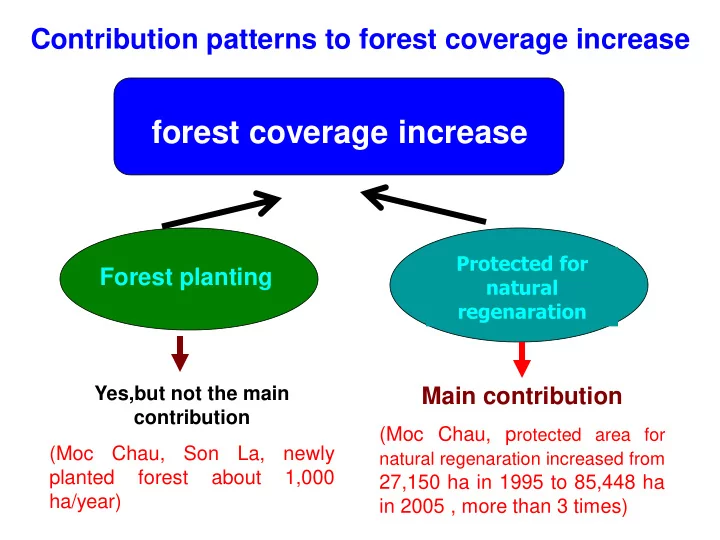

Contribution patterns to forest coverage increase forest coverage increase Protected for Forest planting natural regenaration Yes,but not the main Main contribution contribution (Moc Chau, p rotected area for (Moc Chau, Son La, newly natural regenaration increased from planted forest about 1,000 27,150 ha in 1995 to 85,448 ha ha/year) in 2005 , more than 3 times)
Why fast natural regenaration? Food demands Intensification of flat Using sloping lands for food production and exploitation of lands and terraces natural resources - Fast yield increase, - Production inrease Forests have been - Reduced pressure on protected for natural sloping lands for food production, regeneration. - Reduced forest exploitation.
Increase in food production Increase rice yield in the stage of 1995-2009 in NMR 1995 2000 2005 2009 Comparing 2009 to Year (T/ha) 1995 (%) (T/ha) (T/ha) (T/ha) NMR 2.73 3.59 4.33 4.55 66.7 Whole 3.69 4.24 4.89 5.23 41.7 country
Increase in food production Food per capital in the stage of 1995-2009 in NMR 1995 2000 2005 2009 Comparing Year (kg/ (kg/ (kg/ (kg/ 2009 to person) person) person) person) 1995 (%) NMR 210,4 287,5 361,9 412,3 95,96 Whole 363,1 444,9 480,9 503,7 38,73 country
Increase in forest coverage Whole country NMR Year (%) (%) 1995 28.2 28.5 2000 33.2 34.5 2005 37.9 43.6 2009 39.1 47.1
DIVERSIFICATION - Tea production - Coffees, rubbers - Fruits, flowers and vegetables - Livestock production 42
Tea cultiation Year 2000: Area: 66.7 thousand ha, Yield of 3,1 ton/ha, Year 2009: Area: 135 thousand ha, Yield: 7.15 ton/ha.
Coffee COFFEES AND RUBBERS Arabica coffee and rubber trees Rubber are gradually established and well grow in the region New varieties, adaptive test and cultivation technologies are researched and speeded up large scale. 10/25/2011 44
TEMPERATE FRUIT TREES Appropriately selected to promote under specific temperate Zones in upland regions 10/25/2011 45
VEGETABLE AND FLOWERS Starting introducing commercial fruit, flower and vegetable to exploit potential of diverse climate conditions Production of summer, off-season flowers and vegetable 10/25/2011 46
Developing grass for cattle, buffalos and cows .
CONCLUSIONS 1. Uplands are complicated and diverse WITH MANY CONSTRAINTS but ALSO LOTS OF DEVELOPMENT POTENTIALS. So we have to approach the problems carefully and comprehensively. 2. Intensification of valley land agriculture plays an extremely important role in food security, farmer income and improvement of forest resources and environment protection. 3. Thanks to rapid increase in food production, particularly rice production, the mountainous farmers have can overcome poverty and become rich (planting cash crops, intensive animal raising, development of cottage industries especially the traditional ones, and eco-tourism service). 4. Together with the improvement of forest resources, other resources like water availability, soil fertility, particularly biodiversity will be recovered and ecological environment will be improved as well. 5. If we continue to work in these directions, the sustainability will be sooner achieved.
Recommend
More recommend